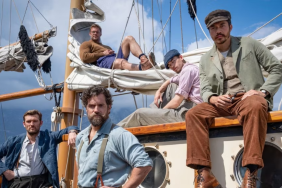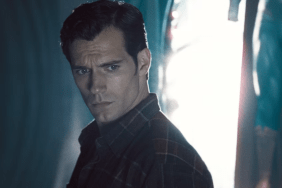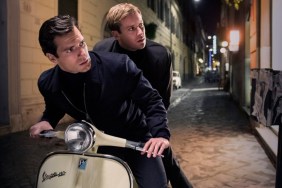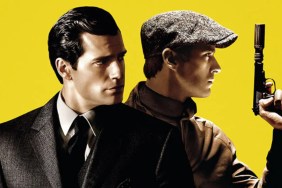
Given that the show came out at the height of the Cold War, just two years after the Cuban Missile Crisis, the success of The Man from U.N.C.L.E. has always seemed somewhat remarkable. Not only did it pair a CIA agent with a KGB agent, but it also portrayed the Soviets as allies, fighting against an even greater threat.
What’s even more remarkable though, is that in spite of the show barely being syndicated at all during the 50 years since it was off the air, it’s remained popular enough for ComingSoon.net to find ourselves at Leavesden Studios in England, standing on a 1960s-era West German street, watching Guy Ritchie and his team shoot the big-budget adaptation.
Watch the New Man from U.N.C.L.E. Trailer!
“After ‘Sherlock’ we looked at every project that was on the market and none of them tickled my fancy,” the director explains, “I always liked the tone of the TV series. I thought it’d have legs and I thought I could do a good job with it.”
It’s still a couple of months before audiences discover how well-placed Ritchie’s self-confidence is, but if the film does somehow fall short, it won’t be for want of trying. We’ve been to some impressive sets over the years, but in terms of ambition, none of them surpass The Man from U.N.C.L.E.
As the crew reset for another take, the publicist looking after our group introduces us to production designer Oliver Scholl. Born the same year “The Man From U.N.C.L.E.” debuted on NBC, Scholl, a veteran of movies like Independence Day and Godzilla, is impossibly fresh and upbeat for someone who’s spent months working at long hours to keep up with the pace of production.
After a brief introduction, Scholl leads us across the backlot, and into the soundstage that houses the production. As he does, the scale of the shoot becomes clear: outside the stage, a group of extras block out a scene set on the flight deck of an aircraft carrier complete with a replica fighter jet. Inside, the 440ft long stage houses an array of sets that stretch off into the distance.
“It’s the longest stage that’s here on the lot, and we have six different sets in here which is really exciting,” reveals Scholl, “We have a dress shop interior, which is West Berlin; we have the bridge of an [aircraft] carrier in here; we have a missile launch area in here, we have an office…; we have Italian castle hallways, and we have the underground laboratory.”
That array of locations should give some sort of clue to the tone of the film – a globetrotting spy-romp, in the vein of the classic Bond films. In some ways, this is reminiscent of the original TV series, although viewers shouldn’t expect the film to mimic that tone too completely.
“What I remember it being, and what it was, are two different things,” Ritchie explains, “but I liked what I remembered, if you know what I mean. That’s what inspired me to do something about it.”
Indeed, one of Ritchie’s key points of comparison for the movie isn’t the original TV series, or even the early films in the Bond franchise, but instead the 1969 film, Butch Cassidy and the Sundance Kid. “It was that bromancey ‘we’ll take ourselves seriously but not too seriously,’ and it broke the pattern of a typical genre. ‘Raindrops Keep Falling on My Head’ popped up in a Western, now that was the first time anyone had done that, the Western was no longer the Western as you’ve seen it.”
To Ritchie, there’s a clear through line between that movie, and much of his own work, particularly when it comes to the interplay between a pair of male leads. As he puts it, “It’s going back to Lock, Stock. I’m interested in that world, so there’s nothing revolutionary that I’m attracted to that as a genre.”
Our tour through the soundstage continues, as Scholl leads us to a raised platform, on which construction is underway on another set. There are still a few elements to add: a dial here, a lever there, and a couple of doors that are still missing, but it’s unmistakably the bridge of an aircraft carrier.

“The way we do this kind of stuff,” Scholl explains, “it’s a lot of research, talking with people, we also use a lot of salvage equipment; a lot of these boards are the real deal. Not always in the right place, but they look like the real stuff.”
By the time of our arrival, Scholl and his team have already spent over a month preparing this one set. Although Scholl describes it as “hard to say, because it doesn’t get built continuously,” he estimates that the construction of the set took three to four weeks, while the dressing has now been ongoing for a fortnight.
With so much work having gone into this set, Scholl moves on to how long the crew will be filming on it. “In the carrier, it’s a pretty short sequence, it’s just two days. It’s a very important sequence though. It’s really tricky… there’s not always a direct correlation between shooting time and scale of the set.”
Scholl leads us out of the aircraft carrier, and further down the soundstage. We move between several flats – the wooden boards that form the walls of the sets – and into a marble-lined Italian palace, complete with sunken sofa, walls that extend nearly to the rafters of the soundstage, and a huge plate glass window. Scholl carries on our conversation from a few moments earlier, “So this was Monday’s half day set.”
As we look around, Scholl points out some of the features, “She wants to rule the world in the end, all villains do, so we have the world up there.“ Everything in the room, it would seem, is there for a reason, “The sculptures were Victoria’s interest, and ties in with Solo’s cover story, with what he is in the movie… Then we have a big window in order to see the shipyards, that’s they’re shipping empire.”
The amount of detail on a given set, and the amount of time spent on constructing it is a balancing act for Scholl. One might assume that the more elaborate sets would be the ones with the most screen time, but that’s not always the case.
“Ideally you want to get to that point, but sometimes it’s just the importance of the scene – if it’s a short scene, but it’s a character introduction of a main character, you want it to have the right impact, so you might give the character a bigger set or make the whole thing more extensive than what you would otherwise.”
That balancing act – servicing the story, without breaking the bank – is one the entire team face on a movie like this, and it begins at the script stage. For Wigram, serving as both writer and producer, that posed a unique challenge, “There was certainly a moment when there was a version of the script which we budgeted was considered to be too expensive by all concerned and we had to do a job of compressing certain scenes, compressing the story to make it work budgetarilly.” As it turns out, Wigram found that this added constraint actually had a positive effect, “Where the centre of the movie was a bit flabby, suddenly the compression made it move much quicker and gave it an energy that it hadn’t had before. It was a pleasant surprise.” ??While the team went into production with a well-developed, well-polished, and on-budget script, the movie on the page isn’t quite what we’ll see on screen. To keep things fresh, Ritchie likes his cast to make slight changes to the dialogue when they’re on set. As Wigram explains, “There’s something about being there, on the set, in costume, in the moment, where you start to get a feel for the scene which is not the same as sitting in your office writing it.”
This way of working suits the cast, particularly Henry Cavill, who plays Napoleon Solo, “It’s one of those things where we all have fun together,” ?the actor reveals, “every morning you know your lines but expect them to change, or be prepared for them to change. Some days they stay exactly as they are and other days they change completely, and that’s quite refreshing. I quite like it, because there’s no opportunity for the scene to get too stale before you actually perform it.”

With dialogue changing on the day, it might seem that as the shoot goes on, the story will change. When this is suggested to Cavil, he cheerfully plays up to the idea, “It’s entirely possible, we’ve had chunks put out and new chunks put in,” but in reality things are actually much less chaotic, as Wigram makes sure to point out, “we have a script, a very clear structure. That doesn’t change at all. There are specific points in each scene that have to be kept,… the dialogue’s tweaked, you’re saying the same line but in a funnier way, we’re not talking about radically altering it.”
Our tour of the stage continues, as Scholl leads us back through the warren of scenery flats, and out into a series of tightly-packed tunnels, some with an industrial vibe, and others that look like they’re hewn from solid rock, “We’re cramming a lot of different sets in here, as I said before. So here we have the back wall of a castle tunnel, intruding into the airplane carrier – a space-time rift or something like this,” Scholl jokes, before leading us round a corner, and into the tunnels, “There’s a lot of running around in these hallways, and they’re reconfigurable. There’s wall pieces that come out and get replaced with different areas.”
He directs our attention to a ramp at one end of the tunnel, “This space here ties in directly with a location we shot in Naples… they go down a ramp in the location, and this matches the bottom of the ramp. Then we go in here, and we’re off in our film tunnel world.” He continues, “If you look at the walls, you’ll see there’s a shift. It goes from more realistic and intact, to a bit more dilapidated and more movie and more moody feel, that will hopefully top at the end of the hall, at the big set there.”
Of course, while this production design is a vital element of the movie, it’s nothing without compelling characters, and strong performances. Initially, the plan had been to make Napoleon Solo an older, more experienced agent – as Wigram puts it, “for commercial reasons; let’s put a big movie star in there.” And as a result of that decision, Tom Cruise was cast in the role. But when he dropped out due to a scheduling clash with Mission Impossible: Rogue Nation, Ritchie and Wigram decided to broaden their options, “There was a moment where we had been considering Henry for Kuryakin, as well as Armie, and we suddenly went ‘you know what? We talked about Henry at the beginning for Solo, why don’t we go back to that idea?’” By this point, Cavill had already been cast in Man of Steel, and was therefore much more bankable, so when the idea of him as the star was pitched to the studio, their response was, according to Wigram, at least, “’you know what, that’s a great idea.’”
It seems to have paid off. As the crew breaks for lunch, we’re shepherded back to the Italian palace set, to speak with Cavill and Hammer. There, they give us some insight into their characters, “My character is not a born CIA agent,” Cavill reveals, “he was very much into the black market and got blackmailed into the CIA. He has learned some skills, but he’s not born and bred by any means… I’m anti-establishment and sort-of self-serving, I would say, whereas Armie…”
Hammer takes Cavill’s cue as a chance to elaborate on Kuryakin, “He’s a hard-core red Communist. It’s all about the establishment and all about the ‘aberration’ about the sense of American entitlement, so there’s a lot of that, a very different way we both approach our jobs, and at different times it definitely bugs both of our characters. Opposite ends of the spectrum really.”
Fortunately, this friction hasn’t spilled over into their real relationship. As with any action film, there are stunt sequences, and while Cavill is modest about his own involvement, he’s vocal about Hammer’s, “There’s a lot of stunt work in this, and I’ll big-up Armie because he won’t do that himself. He’s been doing incredible motorbike stuff, incredible boat stuff as well. I had no idea he was so talented doing those things, his stunt double, poor guy, hardly has a chance to do anything because he’s out there doing it all by himself.”
Although that doesn’t mean Cavill is completely left out of the action, “Generally there’s some cool stuff we get to do… we do get to have a lot of fun.”
Hammer continues Cavill’s train of thought, “We’ve done everything together, we’ve been on speedboats together, I’ve been on the back of his Vespa riding around Rome…”
One of the journalists in the group suggests that this sounds romantic, Hammer agrees, “It was really nice, we had a nice bottle of Chianti.”
Cavill interjects, “Speaking of chemistry.”
“We didn’t have chemistry before Rome, I’ll tell you that.”
“We’ll always have Rome.”
The Man From UNCLE
-
The Man From U.N.C.L.E.

-
The Man From U.N.C.L.E.

-
The Man From U.N.C.L.E.

-
The Man From U.N.C.L.E.

-
The Man From U.N.C.L.E.

-
The Man From U.N.C.L.E.

-
The Man From U.N.C.L.E.

-
The Man From U.N.C.L.E.

-
The Man From U.N.C.L.E.

-
The Man From U.N.C.L.E.

-
The Man From U.N.C.L.E.

-
The Man From U.N.C.L.E.

-
The Man From U.N.C.L.E.

-
The Man From U.N.C.L.E.

-
The Man From U.N.C.L.E.

-
The Man From U.N.C.L.E.

-
The Man From U.N.C.L.E.

-
The Man From U.N.C.L.E.

-
The Man From U.N.C.L.E.

-
The Man From U.N.C.L.E.

-
The Man From U.N.C.L.E.

-
The Man From U.N.C.L.E.

-
The Man From U.N.C.L.E.

-
The Man From U.N.C.L.E.

-
The Man From U.N.C.L.E.

-
The Man From U.N.C.L.E.

-
The Man From U.N.C.L.E.

-
The Man From U.N.C.L.E.

-
The Man From U.N.C.L.E.

-
The Man From U.N.C.L.E.

-
The Man From U.N.C.L.E.

-
The Man From U.N.C.L.E.

-
The Man From U.N.C.L.E.

-
The Man From U.N.C.L.E.

-
The Man From U.N.C.L.E.

-
The Man From U.N.C.L.E.

-
The Man From U.N.C.L.E.

-
The Man From U.N.C.L.E.

-
The Man From U.N.C.L.E.

-
The Man From U.N.C.L.E.

-
The Man From U.N.C.L.E.

-
The Man From U.N.C.L.E.

-
The Man From U.N.C.L.E.










